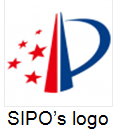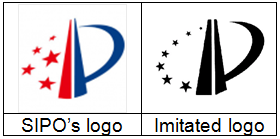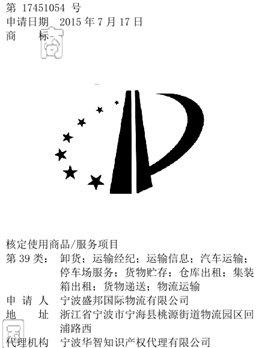By Mr. Tingxi Huo and Ms. Zhanqing Tang of Chofn IP
On June 13, 2016, the Chinese Trademark Office (CTMO) granted provisional approval to a trademark similar to the logo of the State Intellectual Property Office’s (SIPO) of China and published the trademark in the Chinese Trademark Gazette, Issue No. 1507, with particulars shown below.
|
Gazette clipping |
|
|
No. |
17451054 |
|
Application Date |
July 17, 2015 |
|
Class |
39 |
|
Services |
Unloading cargo; Transport brokerage; Transportation information; Car transport; Car parking; Storage of goods; Rental of warehouses; Rental of storage containers; Delivery of goods; Transportation logistics. |
|
Applicant |
Ningbo Shengbang International Logistics Co., Ltd/宁波盛邦国际物流有限公司 |
|
Address |
W. Huipu Rd., Taoyuan Street Logistics Zone, Ninghai, Ningbo, Zhejiang Province, China |
|
Agent |
Ningbo Huazhi IP Agent Ltd. |
|
Deadline to Oppose |
September 13, 2016 |
Unlike the governmental organs in many other countries where the patent authority and the trademark authority are under the same roof of the IP organ, the CTMO, separate from the SIPO, failed to notice the said logo similar to that of a closely-related SIPO’s (see below) and inappropriately granted provisional approval.

This approval has put both the SIPO and CTMO into an embarrassing situation. As an intellectual property protecting governmental organ, the SIPO, accustomed to protecting others’ intellectual property rights, now needs to protect its own intellectual property right.
Although the owner has decided to voluntarily withdraw the application, this matter has attracted much attention from all circles and given rise to sarcastic and heated discussion. Assuming that the application had not been withdrawn, we would analyze from a trademark practitioner’s perspective the possible outcomes, resolutions or influences on the relevant parties as follows to better understand the Chinese Trademark Law and practice.
-
Possible Outcome 1: The SIPO duly files an opposition.
Under Article 33, the SIPO is entitled to file an opposition on or before September 13, 2016, on the basis of absolute or relative grounds, directly by itself or indirectly through a trademark agent. Nevertheless, as a specialized intellectual property protecting organ, it has the budget to protect others’ intellectual property, but probably no budget to protect its own. This may be an issue, though not big.
If an opposition were to be filed, the SIPO should seek legal basis of absolute grounds according to Article 10.1.1 and/or 10.1.8, or relative grounds according to Article 32 of the Chinese Trademark Law below.
Article 10 The following signs shall not be used as trademarks:
(1) those that are identical with or similar to the state name, national flag, national emblem, national anthem, military flag, military emblem, military anthem or medals, etc., of the People’s Republic of China and those that are identical with the names or symbols of state central authorities, or specific names of places where central state authorities are located or the names or images of landmarks;
…
(8) those that are detrimental to socialist morality or practices or that have other unhealthy effects.
Article 32 No trademark application shall infringe upon another party’s existing prior rights. Nor shall an applicant pirate in an unfair manner a mark that is already in use by another party and enjoys substantial influence.
Under Article 10.1.1, the two marks or signs shall be identical with each other. This Article shall not be applied to similarity issues. Obviously, the two marks in question are not identical. Instead, the two marks are only similar, as shown in the chart below. The SIPO’s logo carries five stars, with a layout similar to that of China’s national flag, whereas the imitated mark carries two more stars, not to mention the different colors. Some opine that this Article shall not be simply applied to perfectly identical marks, but also marks very similar. As such, if the SIPO seeks protection under Article 10.1.1, there can be some uncertainties

On relative ground, regretfully, the SIPO does not have any prior application or registration for its logo on the same or similar services. But according to Article 32, it is possible for the SIPO to base the opposition on its existing prior copyright to its logo, as its logo has a relatively high level of originality and the imitated mark is very similar.Therefore, Article 10.1.8, which is generally regarded as an all-functional article, may be a more appropriate basis of the opposition on absolute ground.
On basis of absolute ground Article 10, any other party, in addition to the SIPO, is entitled to file an opposition. The same principle is also applicable to possible invalidation cases to be mentioned below.
-
Possible Outcome 2: The CTMO declares the mark invalid after registration.
Under Article 44, “A registered trademark shall be declared invalid by the Trademark Office if it constitutes violation of Article 10, Article 11 or Article 12 of this Law, or its registration is obtained by deceptive or other improper means. Other entities or individuals may request the Trademark Review and Adjudication Board (TRAB, namely the appeal board) to declare such registered trademark invalid.” There is no time limit for this type of invalidation.
Although embarrassing to declare invalid a registered trademark to which the CTMO itself granted approval, the CTMO remains in a position to thus rectify the situation, according to Article 10 and Article 44, though the owner, if dissatisfied, remains entitled to appeal to the TRAB or further to the courts.
-
Possible Outcome 3: The SIPO requests for TRAB to declare the mark invalid after registration.
Invalidation action can be an option if the SIPO fails to file an opposition in due course and misses the deadline. The SIPO can also intentionally choose to request the TRAB for invalidation, to avoid the CTMO’s examination again as the opposition shall be examined by the CTMO’s Opposition Devision.
After the registration, the SIPO, as well as other entities, can request the TRAB to declare the mark invalid according to the absolute ground Article 10 and Article 44.
In addition, the SIPO can also request for TRAB’s invalidation declaration according to Article 45.1 “If a registered trademark violates the second or third paragraph of Article 13, Article 15, the first paragraph of Article 16, Article 30, Article 31 or Article 32 of this Law, the prior rights holder or a materially-interested party may, within five years of the date of registration of the trademark, request that the Trademark Appeal Board declare the registered trademark invalid…” If a request is filed according to this relative ground on the basis of the SIPO’s prior legitimate rights, only the SIPO or any interested party is qualified to do so within five years after registration.
-
Possible Outcome 4: The owner shall be forbidden to use the mark.
As mentioned above, the forbidden signs under Article 10 shall not be used as trademarks. If the mark is finally not registered whereas the owner still uses the mark in practice, penalty might be available according to Article 52, namely “If an unregistered trademark is illegally passed off as a registered trademark or if use of an unregistered trademark violates Article 10 of this Law, the local administration for industry and commerce shall stop this, order rectification within a specified period, and may additionally circulate a notice on the matter. If the illegal turnover is RMB50,000 or above, it may impose a fine of up to twenty percent of the illegal turnover. If there is no illegal turnover or if the illegal turnover is less than RMB50,000, it may impose a fine of up to RMB10,000.”
However, if the mark finally matures into registration and if the owner uses the mark, it turns out that there is no legal ground for possible penalty against such use under the Trademark Law. Accordingly, it will be more advisable for the SIPO to duly file an opposition, to avoid further embarrassment.
-
Possible Outcome 5: The agent will be safe.
Article 10 actually forbids use of the listed signs and naturally forbids registration thereof. The imitated logo should be deemed violation of Article 10. To regulate the behaviors of the trademark agents, Article 19.2 provides, “A trademark agent shall clearly advise an applicant of the fact that the trademark entrusted for registration may fall under the circumstances prescribed by this Law under which registration is not allowed.”
In other words, an agent is obliged to advise the applicant of the forbidden signs. If the agent is unable to prove that it had advised the applicant of the forbidden signs and the potential violation of Article 10, the agent shall be held liable. Again, it turns out that the Trademark Law fails to provide specific penalty against such violation. As a result, the agent shall be safe from any penalty even though the relevant governmental organs are bothered to a large extent.
Deeper thoughts:
Whatever the outcome is, the CTMO should have rejected this trademark at the very beginning. But how did this inappropriate approval happen?
Since China revised its Trademark Law for the third time and put the revised Law into effect on May 1, 2014, examination of a new application shall be finished within the statutory nine months, counting from the filing date without extension.
China has been the No. 1 trademark filer for fourteen consecutive years since 2002. The CTMO received 2.876 million new applications in 2015 alone. The CTMO is faced with the heavy workload and pressure of time limit and has been forced to expedite examination through reform. The senior experienced examiners are very careful, but can examine limited number of applications. The CTMO recruited a large number of new examiners and set up an Examination Assisting Center. The new examiners in the Center received very brief training before actually examining applications. In the past, there were double checks. However, to further reduce the backlogs and expedite examination, the procedure of double checks has been abolished and only one examiner will be appointed to examine an application. That single examiner’s decision will be immediately final inside the CTMO. Consequently, mistakes or negligence has largely increased.
In our opinion, this accident should set the CTMO thinking about long-term better solutions to similar problems. More importantly, it is high time that the CTMO worked harder to optimize its internal examination procedures to improve the quality of examination.
![]() Chinese IPO's logo imitated.pdf
Chinese IPO's logo imitated.pdf


